HI5017: Standard and Target Costing Report - Holmes Institute
VerifiedAdded on 2022/08/27
|14
|4038
|19
Report
AI Summary
This report examines standard and target costing, two crucial methods in managerial accounting, providing a comparative analysis of their application and impact on business decision-making. The report begins with a definition of standard costing, highlighting its role in identifying variances between actual and standard costs, and its importance in cost control and performance evaluation. It then explores the efficiency of standard costing, particularly in the context of manufacturing concerns in Nigeria, while also acknowledging its drawbacks, such as challenges in addressing consumer needs and adapting to changing market conditions. The report also delves into target costing, defining it as a managerial technique that focuses on pre-determining prices, costs, and profit margins. The report highlights how target costing differs from standard costing, emphasizing its focus on market-driven pricing and proactive cost management. The report explains how target costing influences organizational activities in competitive markets. The report concludes by discussing the strategic advantages of target costing and its role in achieving customer satisfaction and competitive advantage. It draws on various sources to support its arguments and provides a comprehensive overview of the two costing methods and their practical implications.

Running Head: STANDARD AND TARGET COSTING
STANDARD AND TARGET COSTING
NAME OF THE STUDENT
NAME OF THE UNIVERSITY
AUTHORS NOTE
STANDARD AND TARGET COSTING
NAME OF THE STUDENT
NAME OF THE UNIVERSITY
AUTHORS NOTE
Paraphrase This Document
Need a fresh take? Get an instant paraphrase of this document with our AI Paraphraser
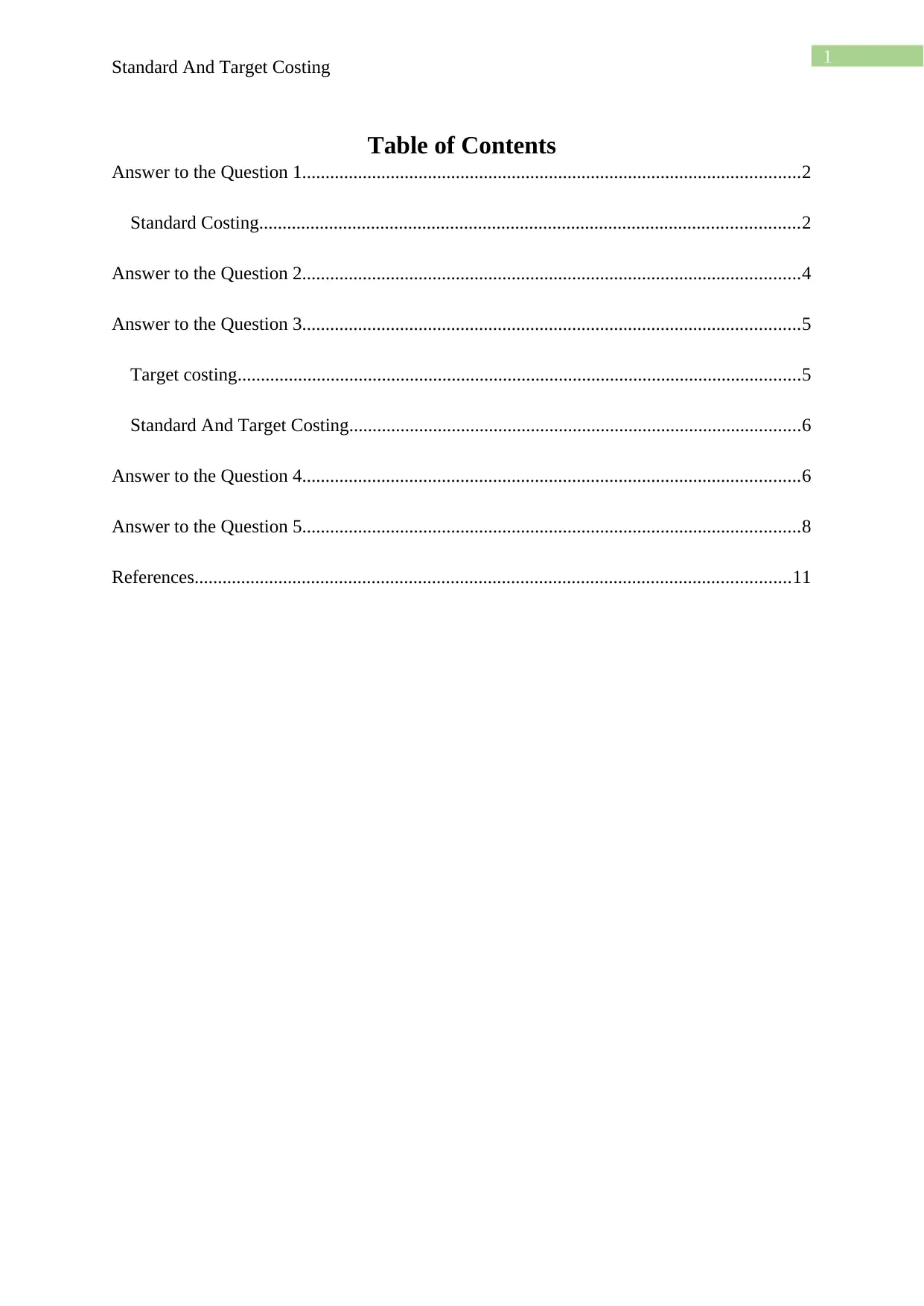
1
Standard And Target Costing
Table of Contents
Answer to the Question 1...........................................................................................................2
Standard Costing....................................................................................................................2
Answer to the Question 2...........................................................................................................4
Answer to the Question 3...........................................................................................................5
Target costing.........................................................................................................................5
Standard And Target Costing.................................................................................................6
Answer to the Question 4...........................................................................................................6
Answer to the Question 5...........................................................................................................8
References................................................................................................................................11
Standard And Target Costing
Table of Contents
Answer to the Question 1...........................................................................................................2
Standard Costing....................................................................................................................2
Answer to the Question 2...........................................................................................................4
Answer to the Question 3...........................................................................................................5
Target costing.........................................................................................................................5
Standard And Target Costing.................................................................................................6
Answer to the Question 4...........................................................................................................6
Answer to the Question 5...........................................................................................................8
References................................................................................................................................11
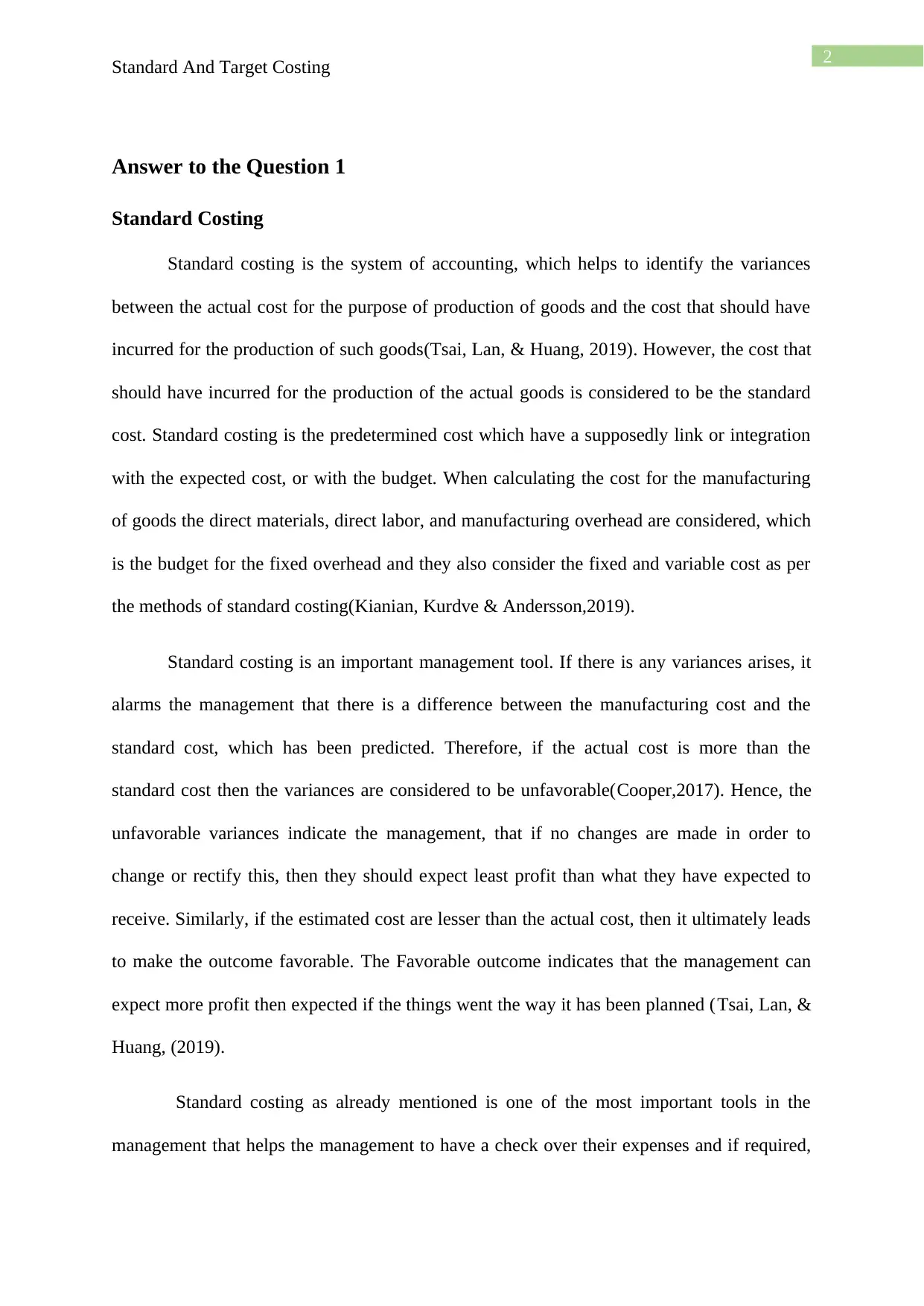
2
Standard And Target Costing
Answer to the Question 1
Standard Costing
Standard costing is the system of accounting, which helps to identify the variances
between the actual cost for the purpose of production of goods and the cost that should have
incurred for the production of such goods(Tsai, Lan, & Huang, 2019). However, the cost that
should have incurred for the production of the actual goods is considered to be the standard
cost. Standard costing is the predetermined cost which have a supposedly link or integration
with the expected cost, or with the budget. When calculating the cost for the manufacturing
of goods the direct materials, direct labor, and manufacturing overhead are considered, which
is the budget for the fixed overhead and they also consider the fixed and variable cost as per
the methods of standard costing(Kianian, Kurdve & Andersson,2019).
Standard costing is an important management tool. If there is any variances arises, it
alarms the management that there is a difference between the manufacturing cost and the
standard cost, which has been predicted. Therefore, if the actual cost is more than the
standard cost then the variances are considered to be unfavorable(Cooper,2017). Hence, the
unfavorable variances indicate the management, that if no changes are made in order to
change or rectify this, then they should expect least profit than what they have expected to
receive. Similarly, if the estimated cost are lesser than the actual cost, then it ultimately leads
to make the outcome favorable. The Favorable outcome indicates that the management can
expect more profit then expected if the things went the way it has been planned (Tsai, Lan, &
Huang, (2019).
Standard costing as already mentioned is one of the most important tools in the
management that helps the management to have a check over their expenses and if required,
Standard And Target Costing
Answer to the Question 1
Standard Costing
Standard costing is the system of accounting, which helps to identify the variances
between the actual cost for the purpose of production of goods and the cost that should have
incurred for the production of such goods(Tsai, Lan, & Huang, 2019). However, the cost that
should have incurred for the production of the actual goods is considered to be the standard
cost. Standard costing is the predetermined cost which have a supposedly link or integration
with the expected cost, or with the budget. When calculating the cost for the manufacturing
of goods the direct materials, direct labor, and manufacturing overhead are considered, which
is the budget for the fixed overhead and they also consider the fixed and variable cost as per
the methods of standard costing(Kianian, Kurdve & Andersson,2019).
Standard costing is an important management tool. If there is any variances arises, it
alarms the management that there is a difference between the manufacturing cost and the
standard cost, which has been predicted. Therefore, if the actual cost is more than the
standard cost then the variances are considered to be unfavorable(Cooper,2017). Hence, the
unfavorable variances indicate the management, that if no changes are made in order to
change or rectify this, then they should expect least profit than what they have expected to
receive. Similarly, if the estimated cost are lesser than the actual cost, then it ultimately leads
to make the outcome favorable. The Favorable outcome indicates that the management can
expect more profit then expected if the things went the way it has been planned (Tsai, Lan, &
Huang, (2019).
Standard costing as already mentioned is one of the most important tools in the
management that helps the management to have a check over their expenses and if required,
⊘ This is a preview!⊘
Do you want full access?
Subscribe today to unlock all pages.

Trusted by 1+ million students worldwide
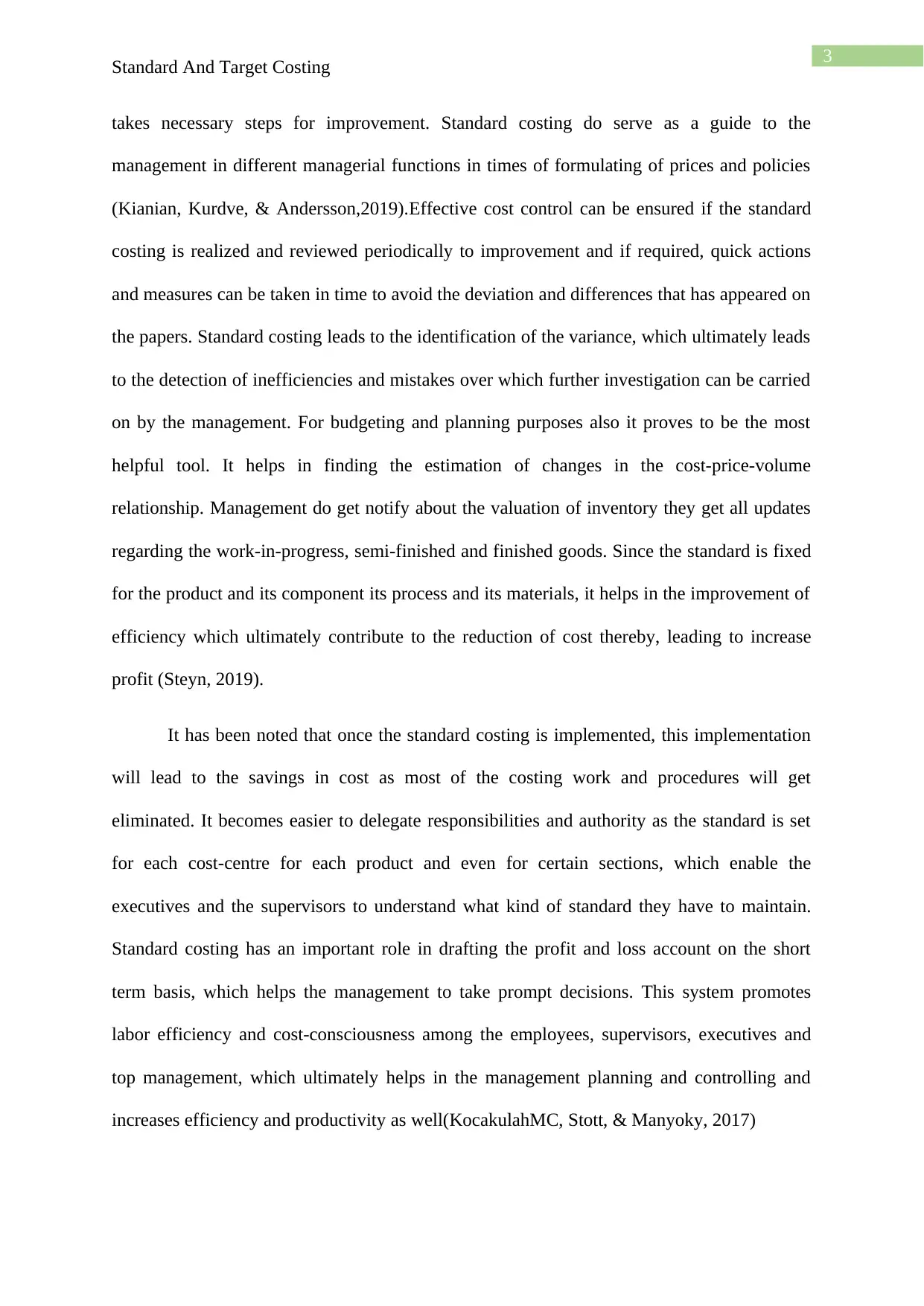
3
Standard And Target Costing
takes necessary steps for improvement. Standard costing do serve as a guide to the
management in different managerial functions in times of formulating of prices and policies
(Kianian, Kurdve, & Andersson,2019).Effective cost control can be ensured if the standard
costing is realized and reviewed periodically to improvement and if required, quick actions
and measures can be taken in time to avoid the deviation and differences that has appeared on
the papers. Standard costing leads to the identification of the variance, which ultimately leads
to the detection of inefficiencies and mistakes over which further investigation can be carried
on by the management. For budgeting and planning purposes also it proves to be the most
helpful tool. It helps in finding the estimation of changes in the cost-price-volume
relationship. Management do get notify about the valuation of inventory they get all updates
regarding the work-in-progress, semi-finished and finished goods. Since the standard is fixed
for the product and its component its process and its materials, it helps in the improvement of
efficiency which ultimately contribute to the reduction of cost thereby, leading to increase
profit (Steyn, 2019).
It has been noted that once the standard costing is implemented, this implementation
will lead to the savings in cost as most of the costing work and procedures will get
eliminated. It becomes easier to delegate responsibilities and authority as the standard is set
for each cost-centre for each product and even for certain sections, which enable the
executives and the supervisors to understand what kind of standard they have to maintain.
Standard costing has an important role in drafting the profit and loss account on the short
term basis, which helps the management to take prompt decisions. This system promotes
labor efficiency and cost-consciousness among the employees, supervisors, executives and
top management, which ultimately helps in the management planning and controlling and
increases efficiency and productivity as well(KocakulahMC, Stott, & Manyoky, 2017)
Standard And Target Costing
takes necessary steps for improvement. Standard costing do serve as a guide to the
management in different managerial functions in times of formulating of prices and policies
(Kianian, Kurdve, & Andersson,2019).Effective cost control can be ensured if the standard
costing is realized and reviewed periodically to improvement and if required, quick actions
and measures can be taken in time to avoid the deviation and differences that has appeared on
the papers. Standard costing leads to the identification of the variance, which ultimately leads
to the detection of inefficiencies and mistakes over which further investigation can be carried
on by the management. For budgeting and planning purposes also it proves to be the most
helpful tool. It helps in finding the estimation of changes in the cost-price-volume
relationship. Management do get notify about the valuation of inventory they get all updates
regarding the work-in-progress, semi-finished and finished goods. Since the standard is fixed
for the product and its component its process and its materials, it helps in the improvement of
efficiency which ultimately contribute to the reduction of cost thereby, leading to increase
profit (Steyn, 2019).
It has been noted that once the standard costing is implemented, this implementation
will lead to the savings in cost as most of the costing work and procedures will get
eliminated. It becomes easier to delegate responsibilities and authority as the standard is set
for each cost-centre for each product and even for certain sections, which enable the
executives and the supervisors to understand what kind of standard they have to maintain.
Standard costing has an important role in drafting the profit and loss account on the short
term basis, which helps the management to take prompt decisions. This system promotes
labor efficiency and cost-consciousness among the employees, supervisors, executives and
top management, which ultimately helps in the management planning and controlling and
increases efficiency and productivity as well(KocakulahMC, Stott, & Manyoky, 2017)
Paraphrase This Document
Need a fresh take? Get an instant paraphrase of this document with our AI Paraphraser
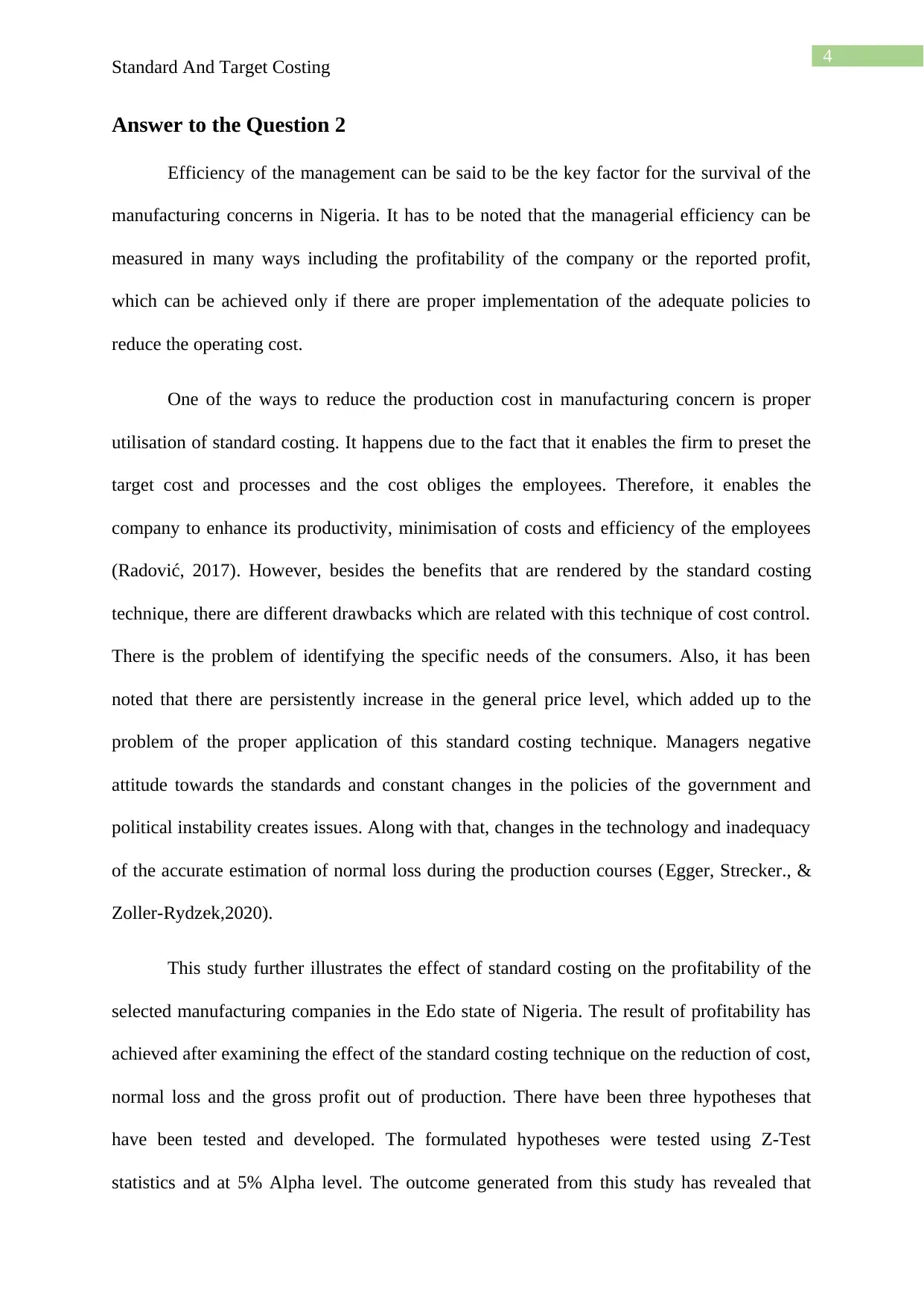
4
Standard And Target Costing
Answer to the Question 2
Efficiency of the management can be said to be the key factor for the survival of the
manufacturing concerns in Nigeria. It has to be noted that the managerial efficiency can be
measured in many ways including the profitability of the company or the reported profit,
which can be achieved only if there are proper implementation of the adequate policies to
reduce the operating cost.
One of the ways to reduce the production cost in manufacturing concern is proper
utilisation of standard costing. It happens due to the fact that it enables the firm to preset the
target cost and processes and the cost obliges the employees. Therefore, it enables the
company to enhance its productivity, minimisation of costs and efficiency of the employees
(Radović, 2017). However, besides the benefits that are rendered by the standard costing
technique, there are different drawbacks which are related with this technique of cost control.
There is the problem of identifying the specific needs of the consumers. Also, it has been
noted that there are persistently increase in the general price level, which added up to the
problem of the proper application of this standard costing technique. Managers negative
attitude towards the standards and constant changes in the policies of the government and
political instability creates issues. Along with that, changes in the technology and inadequacy
of the accurate estimation of normal loss during the production courses (Egger, Strecker., &
Zoller-Rydzek,2020).
This study further illustrates the effect of standard costing on the profitability of the
selected manufacturing companies in the Edo state of Nigeria. The result of profitability has
achieved after examining the effect of the standard costing technique on the reduction of cost,
normal loss and the gross profit out of production. There have been three hypotheses that
have been tested and developed. The formulated hypotheses were tested using Z-Test
statistics and at 5% Alpha level. The outcome generated from this study has revealed that
Standard And Target Costing
Answer to the Question 2
Efficiency of the management can be said to be the key factor for the survival of the
manufacturing concerns in Nigeria. It has to be noted that the managerial efficiency can be
measured in many ways including the profitability of the company or the reported profit,
which can be achieved only if there are proper implementation of the adequate policies to
reduce the operating cost.
One of the ways to reduce the production cost in manufacturing concern is proper
utilisation of standard costing. It happens due to the fact that it enables the firm to preset the
target cost and processes and the cost obliges the employees. Therefore, it enables the
company to enhance its productivity, minimisation of costs and efficiency of the employees
(Radović, 2017). However, besides the benefits that are rendered by the standard costing
technique, there are different drawbacks which are related with this technique of cost control.
There is the problem of identifying the specific needs of the consumers. Also, it has been
noted that there are persistently increase in the general price level, which added up to the
problem of the proper application of this standard costing technique. Managers negative
attitude towards the standards and constant changes in the policies of the government and
political instability creates issues. Along with that, changes in the technology and inadequacy
of the accurate estimation of normal loss during the production courses (Egger, Strecker., &
Zoller-Rydzek,2020).
This study further illustrates the effect of standard costing on the profitability of the
selected manufacturing companies in the Edo state of Nigeria. The result of profitability has
achieved after examining the effect of the standard costing technique on the reduction of cost,
normal loss and the gross profit out of production. There have been three hypotheses that
have been tested and developed. The formulated hypotheses were tested using Z-Test
statistics and at 5% Alpha level. The outcome generated from this study has revealed that
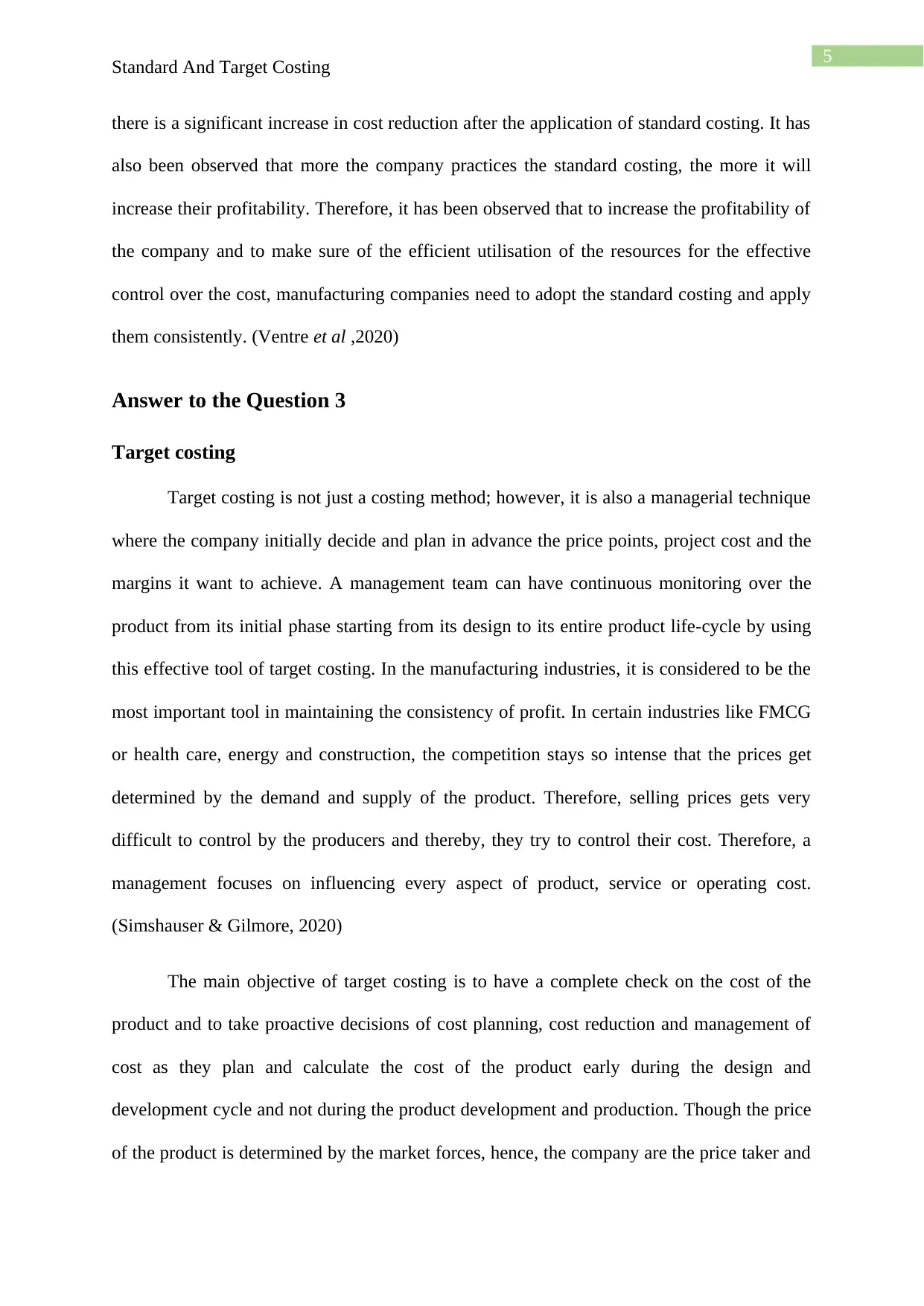
5
Standard And Target Costing
there is a significant increase in cost reduction after the application of standard costing. It has
also been observed that more the company practices the standard costing, the more it will
increase their profitability. Therefore, it has been observed that to increase the profitability of
the company and to make sure of the efficient utilisation of the resources for the effective
control over the cost, manufacturing companies need to adopt the standard costing and apply
them consistently. (Ventre et al ,2020)
Answer to the Question 3
Target costing
Target costing is not just a costing method; however, it is also a managerial technique
where the company initially decide and plan in advance the price points, project cost and the
margins it want to achieve. A management team can have continuous monitoring over the
product from its initial phase starting from its design to its entire product life-cycle by using
this effective tool of target costing. In the manufacturing industries, it is considered to be the
most important tool in maintaining the consistency of profit. In certain industries like FMCG
or health care, energy and construction, the competition stays so intense that the prices get
determined by the demand and supply of the product. Therefore, selling prices gets very
difficult to control by the producers and thereby, they try to control their cost. Therefore, a
management focuses on influencing every aspect of product, service or operating cost.
(Simshauser & Gilmore, 2020)
The main objective of target costing is to have a complete check on the cost of the
product and to take proactive decisions of cost planning, cost reduction and management of
cost as they plan and calculate the cost of the product early during the design and
development cycle and not during the product development and production. Though the price
of the product is determined by the market forces, hence, the company are the price taker and
Standard And Target Costing
there is a significant increase in cost reduction after the application of standard costing. It has
also been observed that more the company practices the standard costing, the more it will
increase their profitability. Therefore, it has been observed that to increase the profitability of
the company and to make sure of the efficient utilisation of the resources for the effective
control over the cost, manufacturing companies need to adopt the standard costing and apply
them consistently. (Ventre et al ,2020)
Answer to the Question 3
Target costing
Target costing is not just a costing method; however, it is also a managerial technique
where the company initially decide and plan in advance the price points, project cost and the
margins it want to achieve. A management team can have continuous monitoring over the
product from its initial phase starting from its design to its entire product life-cycle by using
this effective tool of target costing. In the manufacturing industries, it is considered to be the
most important tool in maintaining the consistency of profit. In certain industries like FMCG
or health care, energy and construction, the competition stays so intense that the prices get
determined by the demand and supply of the product. Therefore, selling prices gets very
difficult to control by the producers and thereby, they try to control their cost. Therefore, a
management focuses on influencing every aspect of product, service or operating cost.
(Simshauser & Gilmore, 2020)
The main objective of target costing is to have a complete check on the cost of the
product and to take proactive decisions of cost planning, cost reduction and management of
cost as they plan and calculate the cost of the product early during the design and
development cycle and not during the product development and production. Though the price
of the product is determined by the market forces, hence, the company are the price taker and
⊘ This is a preview!⊘
Do you want full access?
Subscribe today to unlock all pages.

Trusted by 1+ million students worldwide
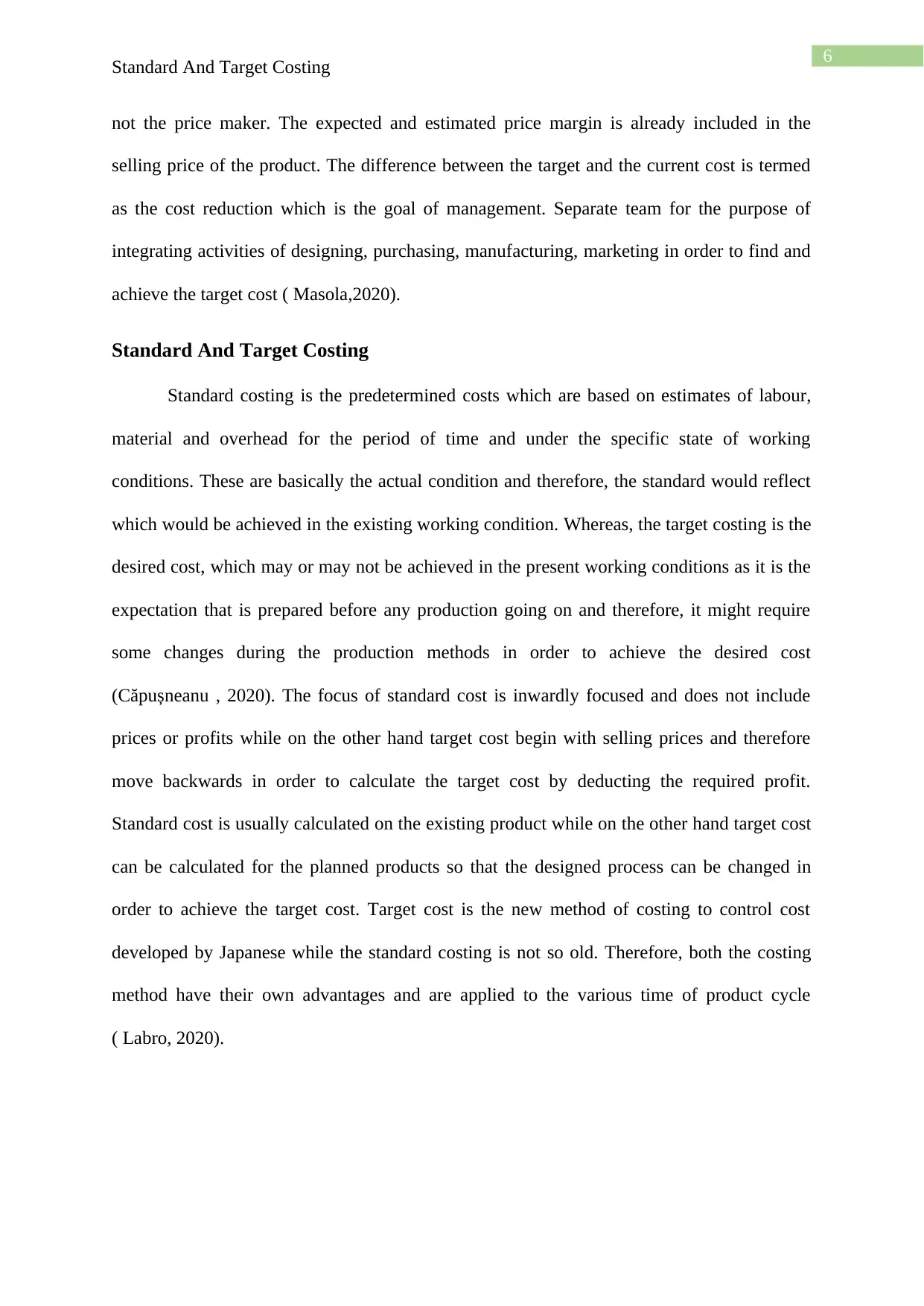
6
Standard And Target Costing
not the price maker. The expected and estimated price margin is already included in the
selling price of the product. The difference between the target and the current cost is termed
as the cost reduction which is the goal of management. Separate team for the purpose of
integrating activities of designing, purchasing, manufacturing, marketing in order to find and
achieve the target cost ( Masola,2020).
Standard And Target Costing
Standard costing is the predetermined costs which are based on estimates of labour,
material and overhead for the period of time and under the specific state of working
conditions. These are basically the actual condition and therefore, the standard would reflect
which would be achieved in the existing working condition. Whereas, the target costing is the
desired cost, which may or may not be achieved in the present working conditions as it is the
expectation that is prepared before any production going on and therefore, it might require
some changes during the production methods in order to achieve the desired cost
(Căpușneanu , 2020). The focus of standard cost is inwardly focused and does not include
prices or profits while on the other hand target cost begin with selling prices and therefore
move backwards in order to calculate the target cost by deducting the required profit.
Standard cost is usually calculated on the existing product while on the other hand target cost
can be calculated for the planned products so that the designed process can be changed in
order to achieve the target cost. Target cost is the new method of costing to control cost
developed by Japanese while the standard costing is not so old. Therefore, both the costing
method have their own advantages and are applied to the various time of product cycle
( Labro, 2020).
Standard And Target Costing
not the price maker. The expected and estimated price margin is already included in the
selling price of the product. The difference between the target and the current cost is termed
as the cost reduction which is the goal of management. Separate team for the purpose of
integrating activities of designing, purchasing, manufacturing, marketing in order to find and
achieve the target cost ( Masola,2020).
Standard And Target Costing
Standard costing is the predetermined costs which are based on estimates of labour,
material and overhead for the period of time and under the specific state of working
conditions. These are basically the actual condition and therefore, the standard would reflect
which would be achieved in the existing working condition. Whereas, the target costing is the
desired cost, which may or may not be achieved in the present working conditions as it is the
expectation that is prepared before any production going on and therefore, it might require
some changes during the production methods in order to achieve the desired cost
(Căpușneanu , 2020). The focus of standard cost is inwardly focused and does not include
prices or profits while on the other hand target cost begin with selling prices and therefore
move backwards in order to calculate the target cost by deducting the required profit.
Standard cost is usually calculated on the existing product while on the other hand target cost
can be calculated for the planned products so that the designed process can be changed in
order to achieve the target cost. Target cost is the new method of costing to control cost
developed by Japanese while the standard costing is not so old. Therefore, both the costing
method have their own advantages and are applied to the various time of product cycle
( Labro, 2020).
Paraphrase This Document
Need a fresh take? Get an instant paraphrase of this document with our AI Paraphraser
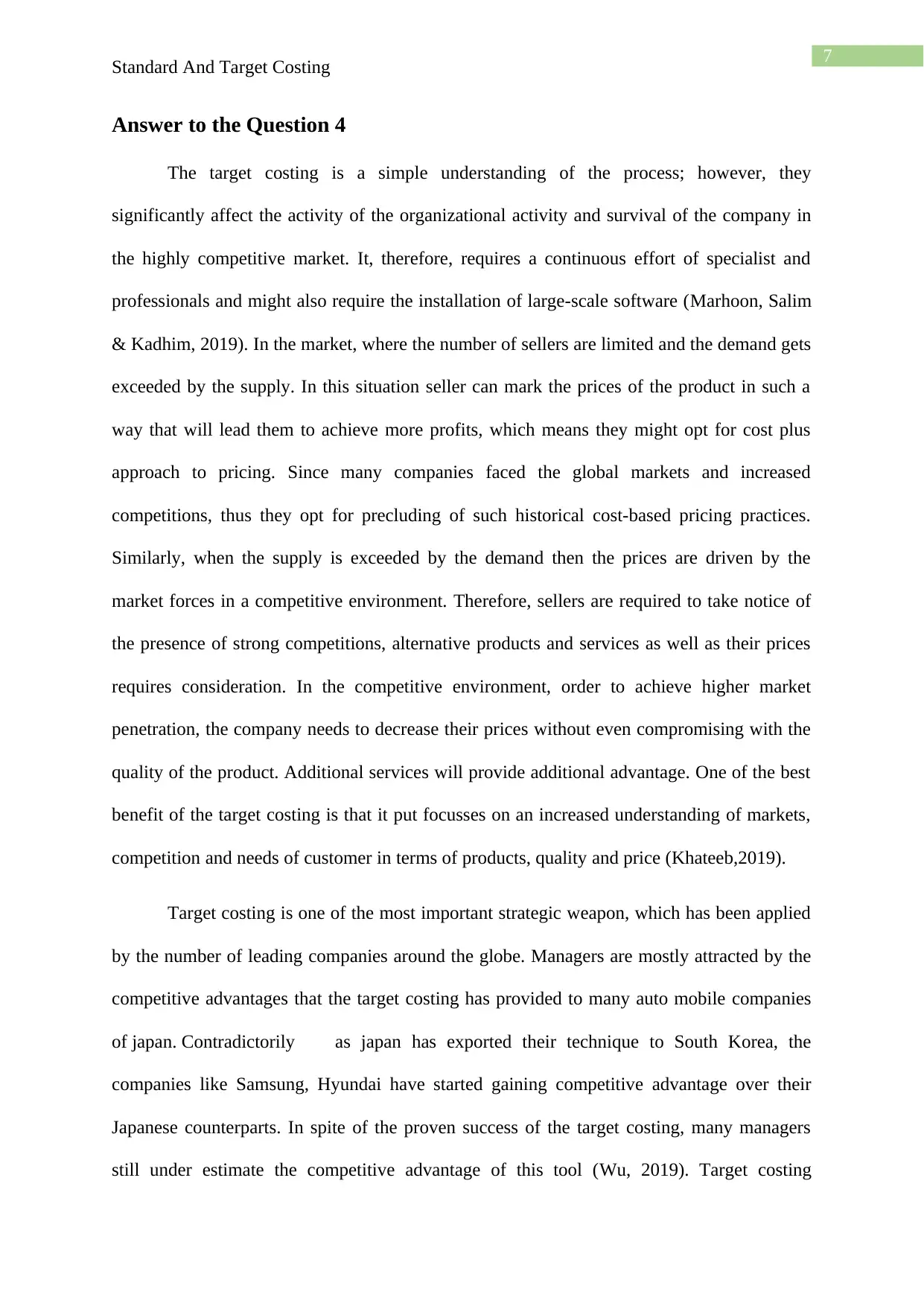
7
Standard And Target Costing
Answer to the Question 4
The target costing is a simple understanding of the process; however, they
significantly affect the activity of the organizational activity and survival of the company in
the highly competitive market. It, therefore, requires a continuous effort of specialist and
professionals and might also require the installation of large-scale software (Marhoon, Salim
& Kadhim, 2019). In the market, where the number of sellers are limited and the demand gets
exceeded by the supply. In this situation seller can mark the prices of the product in such a
way that will lead them to achieve more profits, which means they might opt for cost plus
approach to pricing. Since many companies faced the global markets and increased
competitions, thus they opt for precluding of such historical cost-based pricing practices.
Similarly, when the supply is exceeded by the demand then the prices are driven by the
market forces in a competitive environment. Therefore, sellers are required to take notice of
the presence of strong competitions, alternative products and services as well as their prices
requires consideration. In the competitive environment, order to achieve higher market
penetration, the company needs to decrease their prices without even compromising with the
quality of the product. Additional services will provide additional advantage. One of the best
benefit of the target costing is that it put focusses on an increased understanding of markets,
competition and needs of customer in terms of products, quality and price (Khateeb,2019).
Target costing is one of the most important strategic weapon, which has been applied
by the number of leading companies around the globe. Managers are mostly attracted by the
competitive advantages that the target costing has provided to many auto mobile companies
of japan. Contradictorily as japan has exported their technique to South Korea, the
companies like Samsung, Hyundai have started gaining competitive advantage over their
Japanese counterparts. In spite of the proven success of the target costing, many managers
still under estimate the competitive advantage of this tool (Wu, 2019). Target costing
Standard And Target Costing
Answer to the Question 4
The target costing is a simple understanding of the process; however, they
significantly affect the activity of the organizational activity and survival of the company in
the highly competitive market. It, therefore, requires a continuous effort of specialist and
professionals and might also require the installation of large-scale software (Marhoon, Salim
& Kadhim, 2019). In the market, where the number of sellers are limited and the demand gets
exceeded by the supply. In this situation seller can mark the prices of the product in such a
way that will lead them to achieve more profits, which means they might opt for cost plus
approach to pricing. Since many companies faced the global markets and increased
competitions, thus they opt for precluding of such historical cost-based pricing practices.
Similarly, when the supply is exceeded by the demand then the prices are driven by the
market forces in a competitive environment. Therefore, sellers are required to take notice of
the presence of strong competitions, alternative products and services as well as their prices
requires consideration. In the competitive environment, order to achieve higher market
penetration, the company needs to decrease their prices without even compromising with the
quality of the product. Additional services will provide additional advantage. One of the best
benefit of the target costing is that it put focusses on an increased understanding of markets,
competition and needs of customer in terms of products, quality and price (Khateeb,2019).
Target costing is one of the most important strategic weapon, which has been applied
by the number of leading companies around the globe. Managers are mostly attracted by the
competitive advantages that the target costing has provided to many auto mobile companies
of japan. Contradictorily as japan has exported their technique to South Korea, the
companies like Samsung, Hyundai have started gaining competitive advantage over their
Japanese counterparts. In spite of the proven success of the target costing, many managers
still under estimate the competitive advantage of this tool (Wu, 2019). Target costing
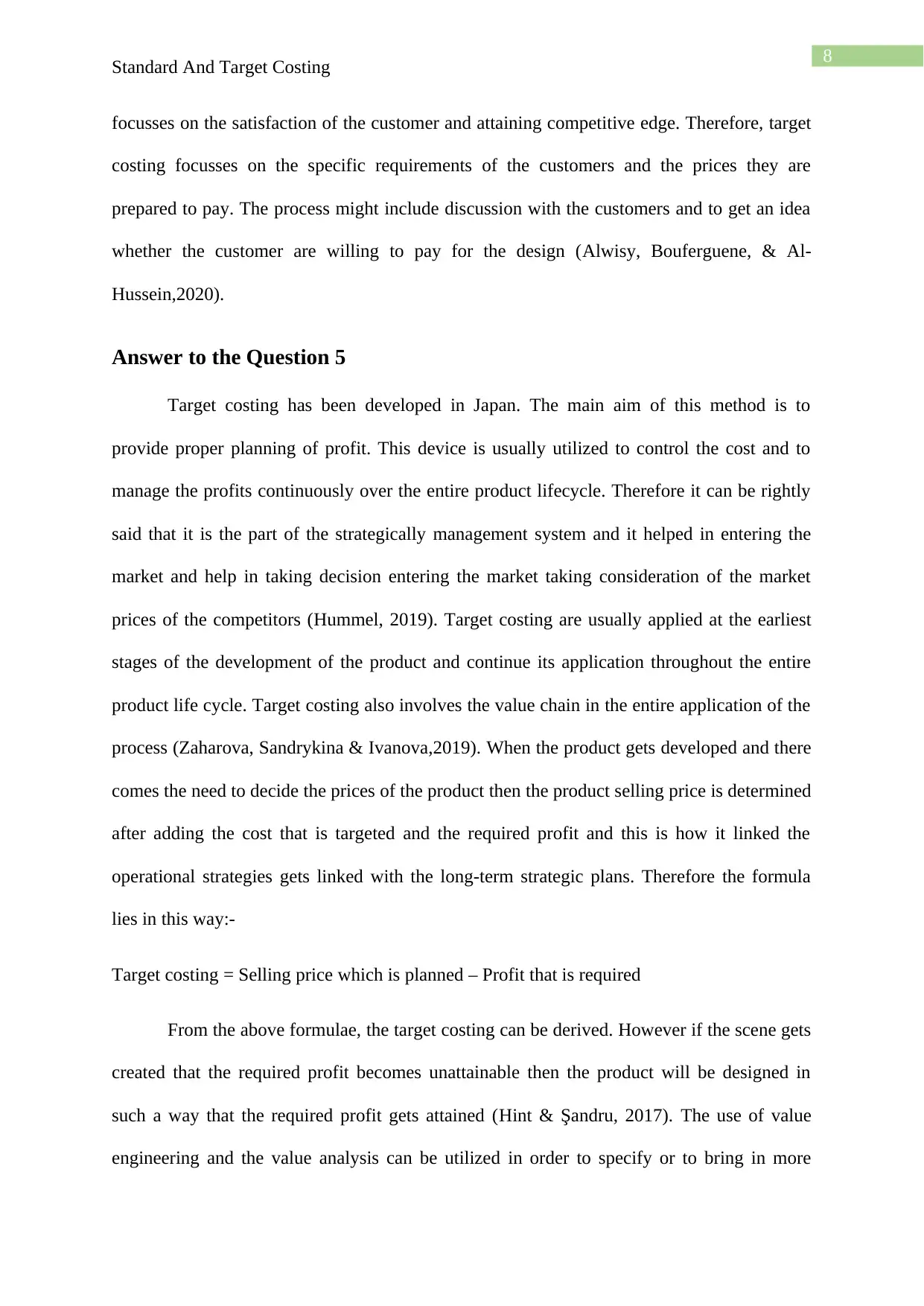
8
Standard And Target Costing
focusses on the satisfaction of the customer and attaining competitive edge. Therefore, target
costing focusses on the specific requirements of the customers and the prices they are
prepared to pay. The process might include discussion with the customers and to get an idea
whether the customer are willing to pay for the design (Alwisy, Bouferguene, & Al-
Hussein,2020).
Answer to the Question 5
Target costing has been developed in Japan. The main aim of this method is to
provide proper planning of profit. This device is usually utilized to control the cost and to
manage the profits continuously over the entire product lifecycle. Therefore it can be rightly
said that it is the part of the strategically management system and it helped in entering the
market and help in taking decision entering the market taking consideration of the market
prices of the competitors (Hummel, 2019). Target costing are usually applied at the earliest
stages of the development of the product and continue its application throughout the entire
product life cycle. Target costing also involves the value chain in the entire application of the
process (Zaharova, Sandrykina & Ivanova,2019). When the product gets developed and there
comes the need to decide the prices of the product then the product selling price is determined
after adding the cost that is targeted and the required profit and this is how it linked the
operational strategies gets linked with the long-term strategic plans. Therefore the formula
lies in this way:-
Target costing = Selling price which is planned – Profit that is required
From the above formulae, the target costing can be derived. However if the scene gets
created that the required profit becomes unattainable then the product will be designed in
such a way that the required profit gets attained (Hint & Şandru, 2017). The use of value
engineering and the value analysis can be utilized in order to specify or to bring in more
Standard And Target Costing
focusses on the satisfaction of the customer and attaining competitive edge. Therefore, target
costing focusses on the specific requirements of the customers and the prices they are
prepared to pay. The process might include discussion with the customers and to get an idea
whether the customer are willing to pay for the design (Alwisy, Bouferguene, & Al-
Hussein,2020).
Answer to the Question 5
Target costing has been developed in Japan. The main aim of this method is to
provide proper planning of profit. This device is usually utilized to control the cost and to
manage the profits continuously over the entire product lifecycle. Therefore it can be rightly
said that it is the part of the strategically management system and it helped in entering the
market and help in taking decision entering the market taking consideration of the market
prices of the competitors (Hummel, 2019). Target costing are usually applied at the earliest
stages of the development of the product and continue its application throughout the entire
product life cycle. Target costing also involves the value chain in the entire application of the
process (Zaharova, Sandrykina & Ivanova,2019). When the product gets developed and there
comes the need to decide the prices of the product then the product selling price is determined
after adding the cost that is targeted and the required profit and this is how it linked the
operational strategies gets linked with the long-term strategic plans. Therefore the formula
lies in this way:-
Target costing = Selling price which is planned – Profit that is required
From the above formulae, the target costing can be derived. However if the scene gets
created that the required profit becomes unattainable then the product will be designed in
such a way that the required profit gets attained (Hint & Şandru, 2017). The use of value
engineering and the value analysis can be utilized in order to specify or to bring in more
⊘ This is a preview!⊘
Do you want full access?
Subscribe today to unlock all pages.

Trusted by 1+ million students worldwide
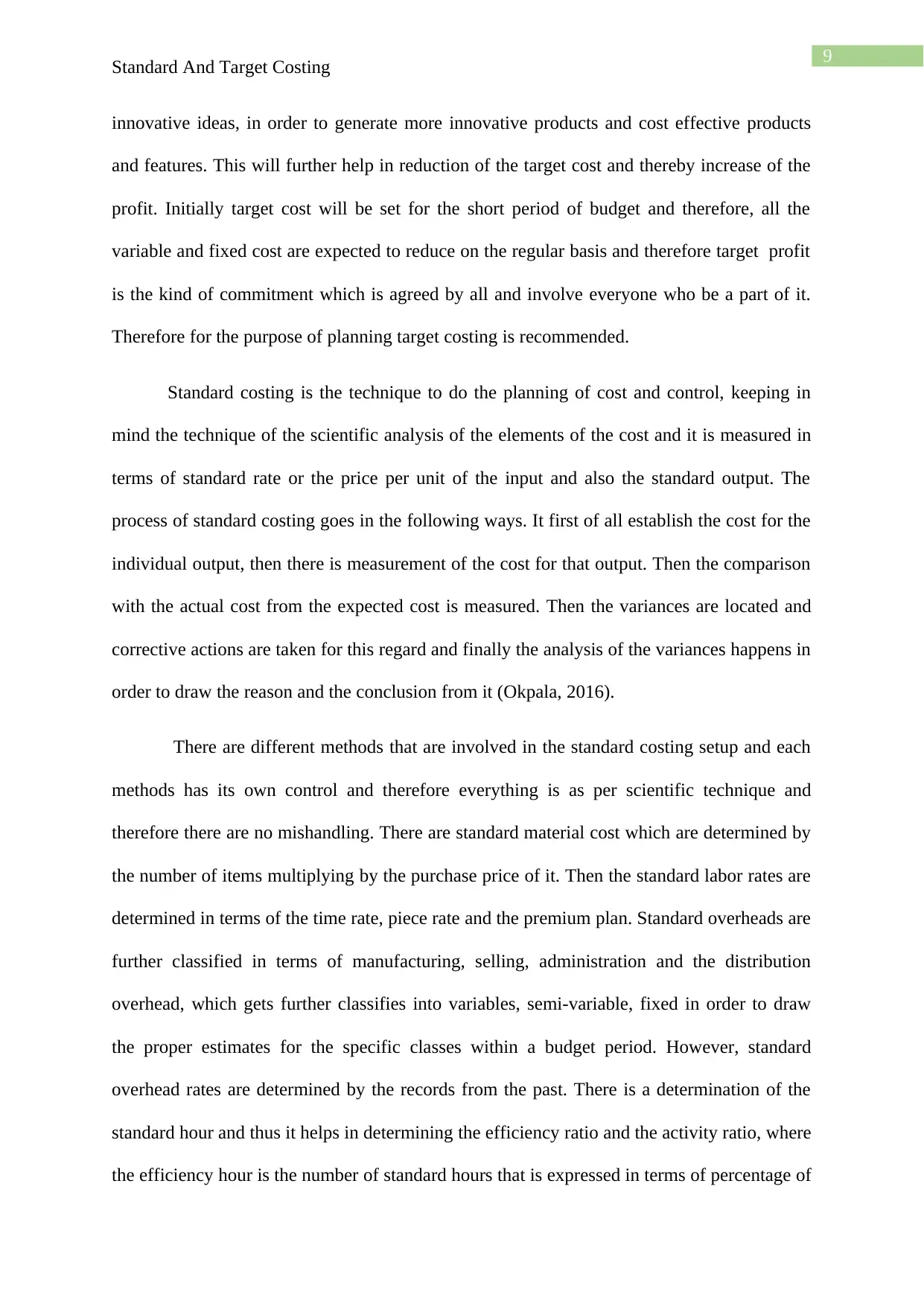
9
Standard And Target Costing
innovative ideas, in order to generate more innovative products and cost effective products
and features. This will further help in reduction of the target cost and thereby increase of the
profit. Initially target cost will be set for the short period of budget and therefore, all the
variable and fixed cost are expected to reduce on the regular basis and therefore target profit
is the kind of commitment which is agreed by all and involve everyone who be a part of it.
Therefore for the purpose of planning target costing is recommended.
Standard costing is the technique to do the planning of cost and control, keeping in
mind the technique of the scientific analysis of the elements of the cost and it is measured in
terms of standard rate or the price per unit of the input and also the standard output. The
process of standard costing goes in the following ways. It first of all establish the cost for the
individual output, then there is measurement of the cost for that output. Then the comparison
with the actual cost from the expected cost is measured. Then the variances are located and
corrective actions are taken for this regard and finally the analysis of the variances happens in
order to draw the reason and the conclusion from it (Okpala, 2016).
There are different methods that are involved in the standard costing setup and each
methods has its own control and therefore everything is as per scientific technique and
therefore there are no mishandling. There are standard material cost which are determined by
the number of items multiplying by the purchase price of it. Then the standard labor rates are
determined in terms of the time rate, piece rate and the premium plan. Standard overheads are
further classified in terms of manufacturing, selling, administration and the distribution
overhead, which gets further classifies into variables, semi-variable, fixed in order to draw
the proper estimates for the specific classes within a budget period. However, standard
overhead rates are determined by the records from the past. There is a determination of the
standard hour and thus it helps in determining the efficiency ratio and the activity ratio, where
the efficiency hour is the number of standard hours that is expressed in terms of percentage of
Standard And Target Costing
innovative ideas, in order to generate more innovative products and cost effective products
and features. This will further help in reduction of the target cost and thereby increase of the
profit. Initially target cost will be set for the short period of budget and therefore, all the
variable and fixed cost are expected to reduce on the regular basis and therefore target profit
is the kind of commitment which is agreed by all and involve everyone who be a part of it.
Therefore for the purpose of planning target costing is recommended.
Standard costing is the technique to do the planning of cost and control, keeping in
mind the technique of the scientific analysis of the elements of the cost and it is measured in
terms of standard rate or the price per unit of the input and also the standard output. The
process of standard costing goes in the following ways. It first of all establish the cost for the
individual output, then there is measurement of the cost for that output. Then the comparison
with the actual cost from the expected cost is measured. Then the variances are located and
corrective actions are taken for this regard and finally the analysis of the variances happens in
order to draw the reason and the conclusion from it (Okpala, 2016).
There are different methods that are involved in the standard costing setup and each
methods has its own control and therefore everything is as per scientific technique and
therefore there are no mishandling. There are standard material cost which are determined by
the number of items multiplying by the purchase price of it. Then the standard labor rates are
determined in terms of the time rate, piece rate and the premium plan. Standard overheads are
further classified in terms of manufacturing, selling, administration and the distribution
overhead, which gets further classifies into variables, semi-variable, fixed in order to draw
the proper estimates for the specific classes within a budget period. However, standard
overhead rates are determined by the records from the past. There is a determination of the
standard hour and thus it helps in determining the efficiency ratio and the activity ratio, where
the efficiency hour is the number of standard hours that is expressed in terms of percentage of
Paraphrase This Document
Need a fresh take? Get an instant paraphrase of this document with our AI Paraphraser
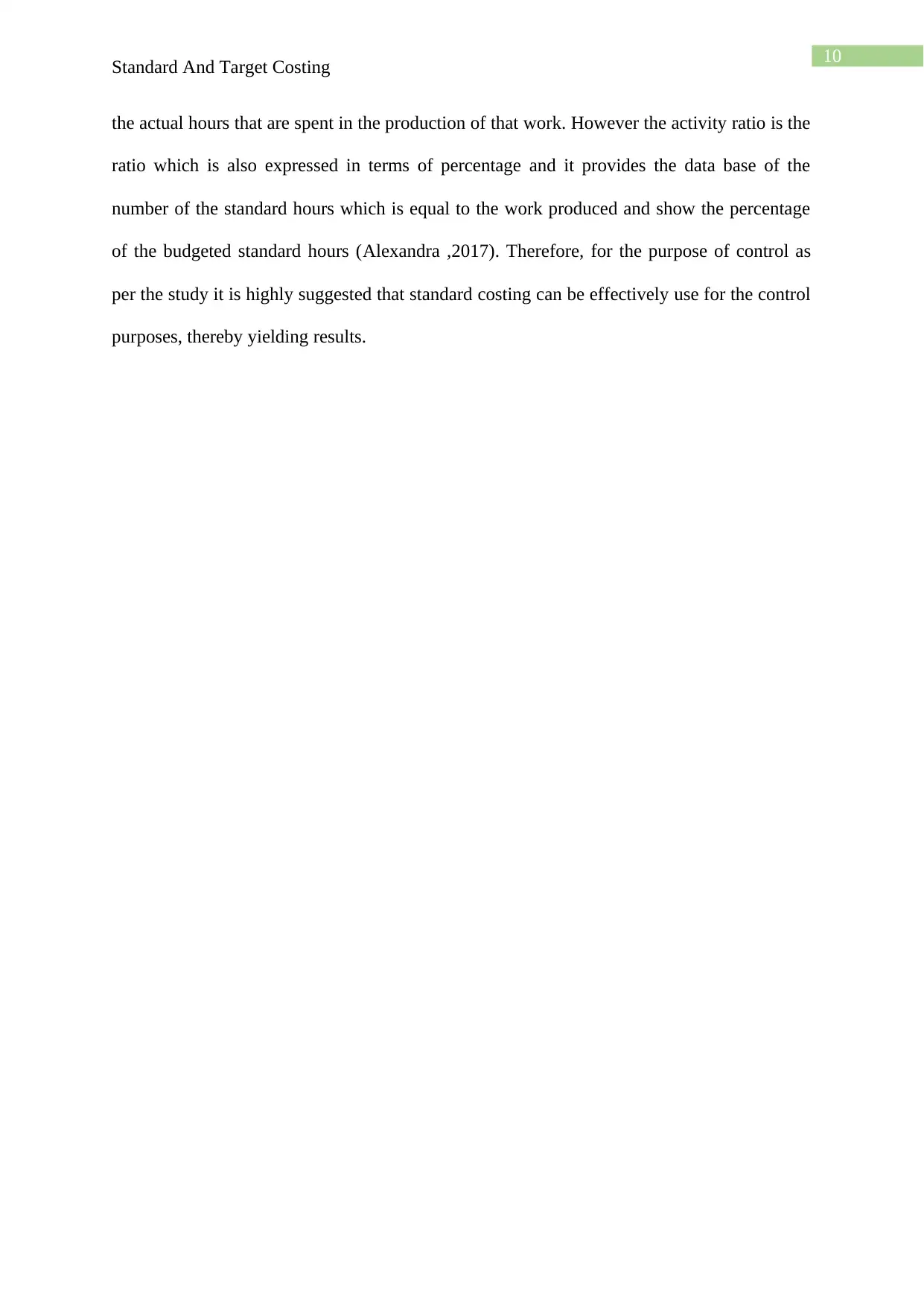
10
Standard And Target Costing
the actual hours that are spent in the production of that work. However the activity ratio is the
ratio which is also expressed in terms of percentage and it provides the data base of the
number of the standard hours which is equal to the work produced and show the percentage
of the budgeted standard hours (Alexandra ,2017). Therefore, for the purpose of control as
per the study it is highly suggested that standard costing can be effectively use for the control
purposes, thereby yielding results.
Standard And Target Costing
the actual hours that are spent in the production of that work. However the activity ratio is the
ratio which is also expressed in terms of percentage and it provides the data base of the
number of the standard hours which is equal to the work produced and show the percentage
of the budgeted standard hours (Alexandra ,2017). Therefore, for the purpose of control as
per the study it is highly suggested that standard costing can be effectively use for the control
purposes, thereby yielding results.
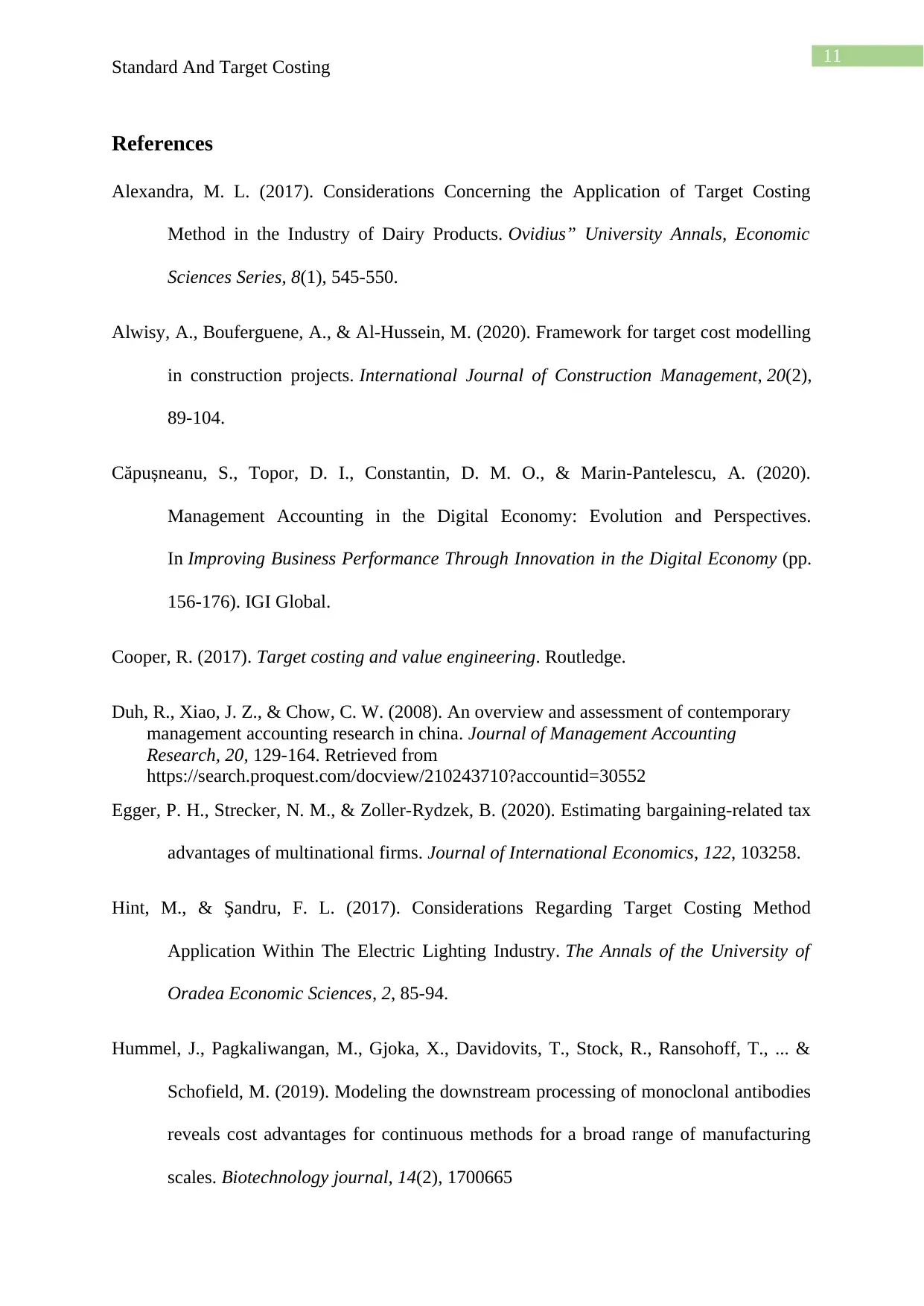
11
Standard And Target Costing
References
Alexandra, M. L. (2017). Considerations Concerning the Application of Target Costing
Method in the Industry of Dairy Products. Ovidius” University Annals, Economic
Sciences Series, 8(1), 545-550.
Alwisy, A., Bouferguene, A., & Al-Hussein, M. (2020). Framework for target cost modelling
in construction projects. International Journal of Construction Management, 20(2),
89-104.
Căpușneanu, S., Topor, D. I., Constantin, D. M. O., & Marin-Pantelescu, A. (2020).
Management Accounting in the Digital Economy: Evolution and Perspectives.
In Improving Business Performance Through Innovation in the Digital Economy (pp.
156-176). IGI Global.
Cooper, R. (2017). Target costing and value engineering. Routledge.
Duh, R., Xiao, J. Z., & Chow, C. W. (2008). An overview and assessment of contemporary
management accounting research in china. Journal of Management Accounting
Research, 20, 129-164. Retrieved from
https://search.proquest.com/docview/210243710?accountid=30552
Egger, P. H., Strecker, N. M., & Zoller-Rydzek, B. (2020). Estimating bargaining-related tax
advantages of multinational firms. Journal of International Economics, 122, 103258.
Hint, M., & Şandru, F. L. (2017). Considerations Regarding Target Costing Method
Application Within The Electric Lighting Industry. The Annals of the University of
Oradea Economic Sciences, 2, 85-94.
Hummel, J., Pagkaliwangan, M., Gjoka, X., Davidovits, T., Stock, R., Ransohoff, T., ... &
Schofield, M. (2019). Modeling the downstream processing of monoclonal antibodies
reveals cost advantages for continuous methods for a broad range of manufacturing
scales. Biotechnology journal, 14(2), 1700665
Standard And Target Costing
References
Alexandra, M. L. (2017). Considerations Concerning the Application of Target Costing
Method in the Industry of Dairy Products. Ovidius” University Annals, Economic
Sciences Series, 8(1), 545-550.
Alwisy, A., Bouferguene, A., & Al-Hussein, M. (2020). Framework for target cost modelling
in construction projects. International Journal of Construction Management, 20(2),
89-104.
Căpușneanu, S., Topor, D. I., Constantin, D. M. O., & Marin-Pantelescu, A. (2020).
Management Accounting in the Digital Economy: Evolution and Perspectives.
In Improving Business Performance Through Innovation in the Digital Economy (pp.
156-176). IGI Global.
Cooper, R. (2017). Target costing and value engineering. Routledge.
Duh, R., Xiao, J. Z., & Chow, C. W. (2008). An overview and assessment of contemporary
management accounting research in china. Journal of Management Accounting
Research, 20, 129-164. Retrieved from
https://search.proquest.com/docview/210243710?accountid=30552
Egger, P. H., Strecker, N. M., & Zoller-Rydzek, B. (2020). Estimating bargaining-related tax
advantages of multinational firms. Journal of International Economics, 122, 103258.
Hint, M., & Şandru, F. L. (2017). Considerations Regarding Target Costing Method
Application Within The Electric Lighting Industry. The Annals of the University of
Oradea Economic Sciences, 2, 85-94.
Hummel, J., Pagkaliwangan, M., Gjoka, X., Davidovits, T., Stock, R., Ransohoff, T., ... &
Schofield, M. (2019). Modeling the downstream processing of monoclonal antibodies
reveals cost advantages for continuous methods for a broad range of manufacturing
scales. Biotechnology journal, 14(2), 1700665
⊘ This is a preview!⊘
Do you want full access?
Subscribe today to unlock all pages.

Trusted by 1+ million students worldwide
1 out of 14
Related Documents
Your All-in-One AI-Powered Toolkit for Academic Success.
+13062052269
info@desklib.com
Available 24*7 on WhatsApp / Email
![[object Object]](/_next/static/media/star-bottom.7253800d.svg)
Unlock your academic potential
Copyright © 2020–2025 A2Z Services. All Rights Reserved. Developed and managed by ZUCOL.





